What is Polypropylene Fabric: Uses & Properties of PP Material
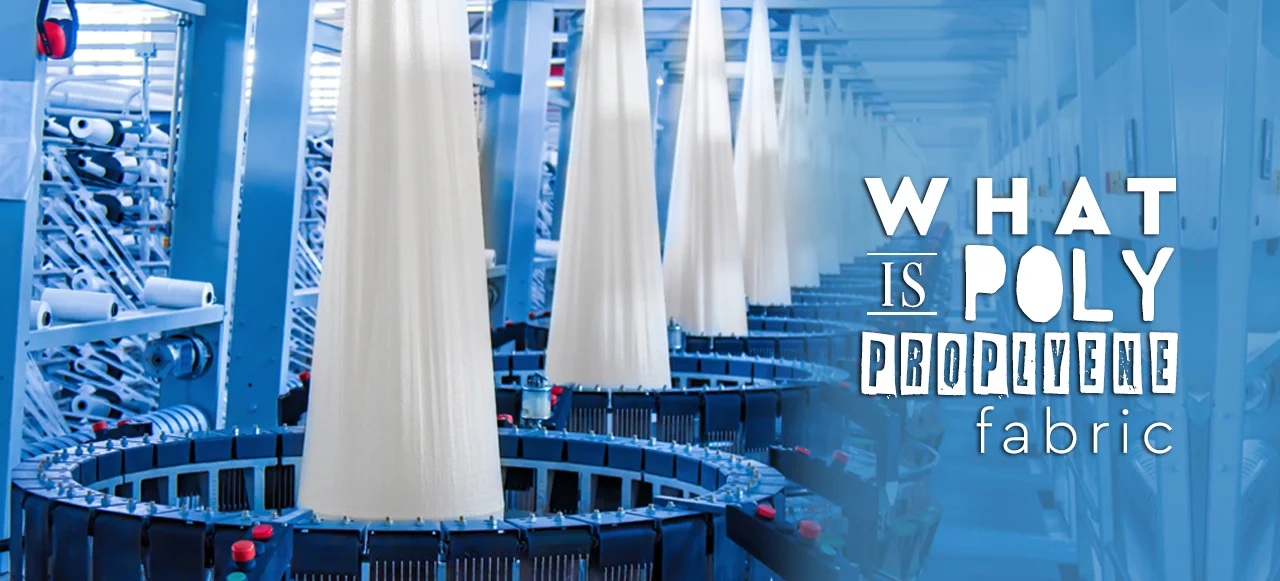
When you think of fabric, you probably don’t think it could be made of the same material as a food tray. However, polypropylene (PP) is a type of plastic with many applications, including fabric. In the following guide, we will address many of your questions about polypropylene fabric, including:
- What is polypropylene fabric?
- What are the types of polypropylene?
- What are some applications of polypropylene fabric?
What is Polypropylene Fabric?
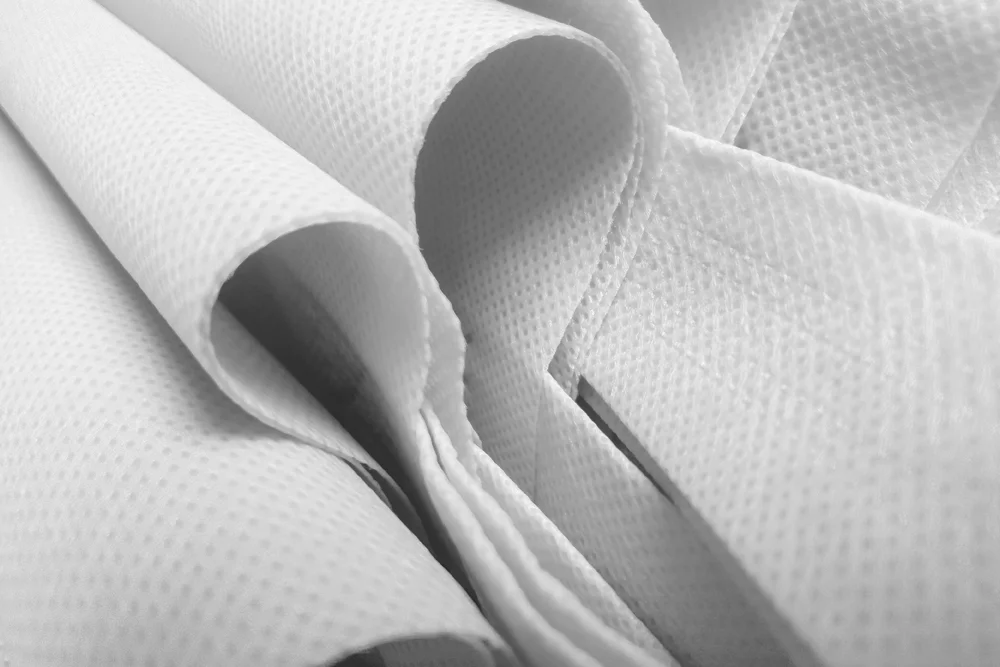
Polypropylene fabric is a textile made from PP, which is a thermoplastic polymer commonly used in food packaging, plastic furniture, films, automotive parts, and medical devices. This plastic is a linear hydrocarbon polymer, and it is one of the most popular plastics due to its low cost and easy manufacturability.
You can make either woven or non-woven polypropylene fabric, depending on the manufacturing process. No matter how you create it, polypropylene fabric resists staining, fading, and water absorption. Furthermore, it is flexible, lightweight, durable, breathable, moisture-wicking, recyclable, and sometimes even fire-resistant.
Common uses for polypropylene
Polypropylene fabric is used in many commercial and industrial applications. You can find it in:
- Thermal insulation
- Sheets
- Blankets
- Clothing
- Mats
- Carpets & carpet tiles
- Reusable shopping bags
- Medical face masks
- Performance wear
- Backpacks
- Lunch bags
- Upholstery
- PP woven fabric rolls
Polypropylene Fabric Material Properties
While it seems unconventional, polypropylene has excellent material properties that translate well to fabric. Some of PP’s material properties include:
- High heat deflection temperature (HDT)
- Durability
- Low cost to produce
- Dimensional stability
- Low density
- Stiffness
- Abrasion resistance
- High tensile strength
- Chemical resistance
Since polypropylene is a thermoplastic, you can melt it, mold it into new shapes, and cool it to the solid-state multiple times. It will degrade in quality each time due to the loss of latent heat, but you can still recycle polypropylene.
These properties make polypropylene textiles feasible for many applications. For instance, the chemical resistance makes it useful for protective clothing and gloves. Additionally, luggage benefits from its abrasion resistance.
Technically, polypropylene will never get dirty. This property is due to inactive dye sites: if something spills or soils the fabric, the stain sits between the fibers. This factor makes it extremely easy to clean with cleaners like bleach, all without the risk of changing the color. In essence, polypropylene fabrics are colorfast, resistant, and cleanable.
Recyclability of Polypropylene
Polypropylene also has the advantage of reusability and recyclability. Compared to other types of plastic, this is a significant environmental feature.
However, it is a class 5 recyclable material. This class indicates that only around 1-6% of the material will get recycled. Researchers are working on chemical recycling processes that isolate the monomers to reform the plastic.
Additionally, polypropylene is not recyclable everywhere, so it is essential to check with local waste management companies or government agencies; if they recycle polypropylene, separate it from other types of plastics before disposal.
How Is Polypropylene Fabric Made (and What Is This Material Made of?)
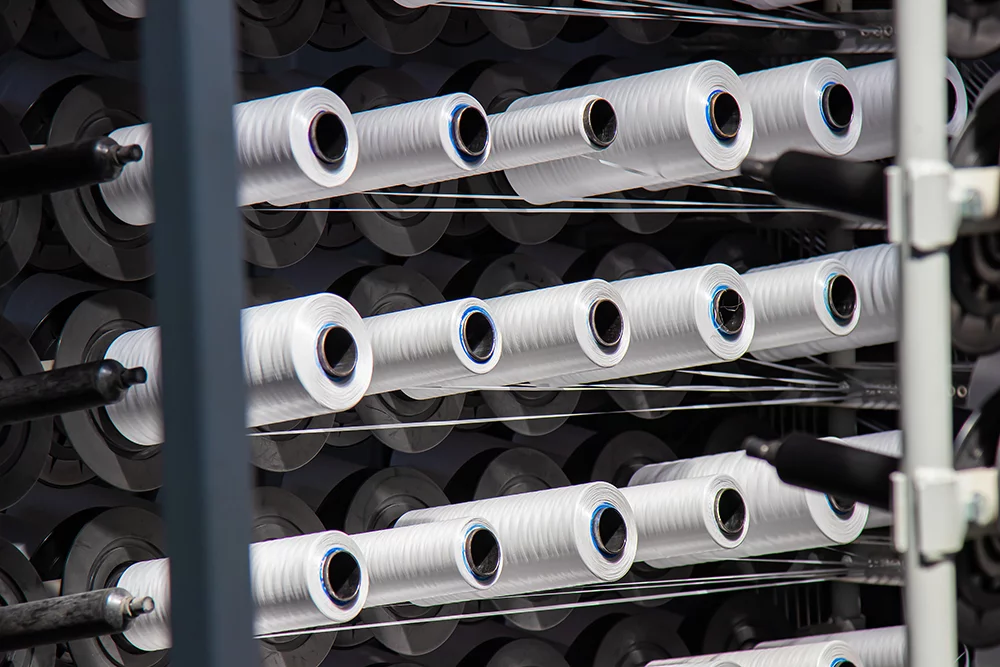
Polypropylene is made through addition polymerization, meaning the material is formed when you:
- Break a benzoyl peroxide (BP) pi bond using heat to create BP free radicals
- Initiate the breaking of the propylene monomer’s pi bond using the BP free radicals and heat
- Create free radicals at the breaking point of the propylene monomer
- Allow electrons to react and form a covalent bond between the free radical of half of the BP and one of the radicals on the propylene to create a growing center
- Let more monomer particles attach to the growing center by the free radical of the propylene
- Terminate the process when the desired size is reached by combining two growing centers
Woven Polypropylene Fabric
Woven polypropylene fabric is made using an extrusion process. Polypropylene powder, activated calcium carbonate, and additives (e.g., colorants or flame-resistant additives) get poured into a mixer. The materials get blended from a low to high speed for a specific time to create a uniform mixture.
Then, the mixture goes through a feeding screw to enter a barrel in a screw-and-barrel system. Using viscous heating and external heaters, the powder undergoes melting and plasticizing. Next, it gets extruded from the system into a water tank that cools and shapes the plastic. A hygroscopic fan provides additional cooling.
A granulator cuts the plastic into strips that go through a vibrating screen. Then, a conveying fan transports the strips to a fluidized bed for treatment before sending it to a material pool for inspection. This process creates raw materials.
Once the material passes inspection, the raw material gets sent into an extruder. The polypropylene gets heated and sheared by the screw-and-barrel system so that it can get extruded from the system at a constant pressure. This material gets cooled, sliced into wires, and treated for use as a thread.
Oftentimes, the material will get extruded through a spinneret. Spinnerets have multiple small holes that create long, narrow filaments that you can spin into yarns. The spinneret uses a higher temperature than a traditional extruder to create a silk-like thread. After extrusion, this thread can undergo similar processing to traditional threads to make textiles for commercial production.
Non-Woven Polypropylene Fabric
Non-woven polypropylene fabric is made by taking polypropylene resin blocks, melting them, and pressing them into sheets of the desired thickness. You can then mold and cut the sheets into the desired shape.
The desired qualities of the fiber depend on its intended use. For example, outdoor furniture needs more durable material than a steering wheel cover. You combine the polypropylene resin with additives to produce the desired result for the intended application.
Additives include things like fillers, stabilizers, antioxidants, UV protection, and colorants, which improve many of polypropylene’s physical properties. Generally, polypropylene textile features 98% polymer and 2% additives.
Polypropylene Structure Formula
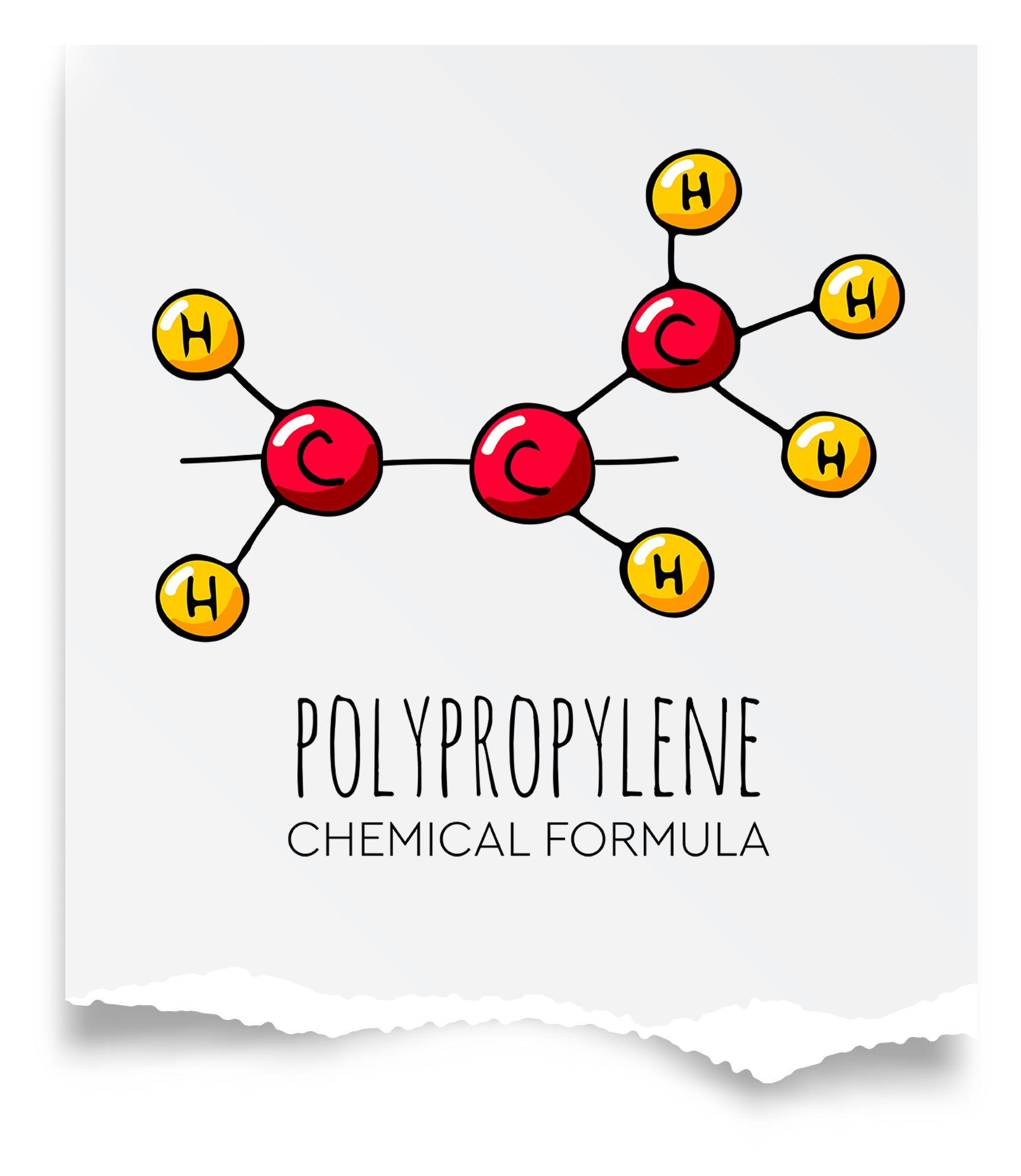
Polypropylene’s chemical formula is C3H6, meaning it is composed entirely of carbon and oxygen atoms. You can see the chemical formula in the repeat unit structure, as seen in parentheses in the above photo. This structure gets repeated n times to create the polymer polypropylene.
Polypropylene has a CH3 pendant group, which contributes to its strength, high heat deflection temperature, stiffness, and other material properties.
One property it exhibits is a relatively high percent crystallinity (up to 75%) for a semi-crystalline material. A high percent crystallinity indicates that the molecules are arranged in an orderly fashion, and it increases the strength.
Since polypropylene is a viscoelastic thermoplastic, it undergoes elastic and viscoelastic recovery. When you apply stress below the yield strength, it will recover its strain completely.
The melting point of polypropylene is around 160 degrees Celsius. At this temperature, it melts into a syrup-like liquid. When in the liquid state, you can mold the polypropylene and cool it to make it a solid.
However, the working range depends more on the heat deflection temperature, which ranges from 70-100 degrees Celsius. The heat deflection temperature measures the plastic’s ability to bear a load at elevated temperatures.
Since the heat deflection temperature falls short of the temperature of fire, you will need to use additives to make it flame resistant when processing it into a fabric.
Types of Polypropylene Materials: Benefits & Uses
All forms of polypropylene consist of multiple propylene monomers bound together with high-strength covalent bonds. However, you can manipulate these monomers during the manufacturing process to create many different types of polypropylene materials.
Biaxially Oriented Polypropylene (BOPP) Film
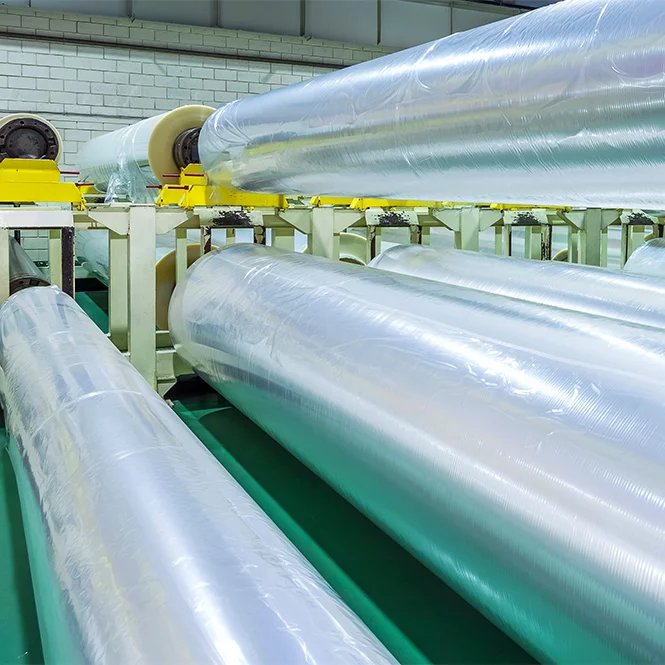
BOPP film is made from polypropylene that gets film stretched along the transverse and longitudinal axes. Since it is pulled in two directions, you get biaxial molecular chain orientation. Manufacturers produce BOPP film with either a tubular or tenter frame process.
You can laminate BOPP film on other forms of polypropylene to boost their physical properties and create high-quality products, such as PP woven bags.
Biaxially Oriented Polypropylene Properties & Benefits
- Increased stiffness
- Improved clarity
- Increased toughness
- Grease and oil resistance
- Oxidation resistance
- An improved barrier to prevent oxygen and water vapor permeation
- Better impact resistance, even at low temperatures
- Greater durability and longevity
- Allows for high-quality graphic printing
- Lightweight
- Moisture and water resistance
- Low cost
Typical Biaxially Oriented Polypropylene Uses
- PP woven bags
- Dry food packaging
- Retail clothing packaging
- Animal feed storage
- Grass seed storage
- Soil, sand, and fertilizer storage
- Snack and tobacco packaging
- Shrinkwrap and heat-shrinkable films
- Dielectric film on capacitors
Polypropylene Homopolymer
Polypropylene homopolymer is the most widely used type of PP. As the name suggests, it features only propylene monomers in their solid, semi-crystalline form. There can be n propylene repeat units in the structure, but there will not be any other monomers.
Polypropylene Homopolymer Properties & Benefits
- High strength-to-weight ratio
- Stronger and stiffer than copolymer
- Greater chemical resistance
- Weldability
- Corrosion resistance
- Processability
- Impact resistance
Typical Polypropylene Homopolymer Uses
- Food packaging
- Medical devices
- Tanks
- Scrubbers
- Electrical components
- Fume hoods
Polypropylene Copolymer
Polypropylene copolymers can be either random or block copolymers. A copolymer is a combination of two different monomers.
Random polypropylene copolymers feature propylene and ethylene. You do not have to compare polyethylene vs. polypropylene bags if you combine the two materials into one. Generally, these copolymers have 6% polyethylene incorporated randomly throughout the polypropylene chains.
Block polypropylene copolymers use 5-15% polyethylene. The monomer units of ethylene and propylene are arranged in patterns (blocks). The regular order gives these more strength, toughness, and ductility compared to random copolymers. However, the random ones have more transparency and flexibility.
Polypropylene Copolymer Properties & Benefits
- Better impact strength, toughness, and durability than homopolymer
- Stress crack resistance
- Toughness in low temperatures
- Processability
- Chemical resistance
- Lightweight
- Moisture resistance
- Stain resistance
Typical Polypropylene Copolymer Uses
- Food packaging (random copolymer only)
- Stationery
- Reusable containers
- Textiles
- Polymer banknotes
- Laboratory equipment
- Automotive components
Electrostatic Non-Woven Polypropylene Fibers
Creating non-woven polypropylene fibers using an electrostatic melt-blown process produces extra-fine microfibers with diameters reaching 600 nm. The electrostatic forces act with the air stream during spinning to produce fine fibers. Recently, this type of PP has gained attention for its use in N95 masks as a filter.
Electrostatic Non-Woven Polypropylene Properties & Benefits
- Low cost
- Moisture resistance
- Stability
- Color retention
- Moderate tensile strength
- Resistance to high temperatures
- Lightweight
- Insulation
Typical Electrostatic Non-Woven Polypropylene Uses
- N95 and surgical masks
- Hospital gowns
- Medical apparel like hospital gowns, surgical covers, shoe covers, caps, and gloves
- Bath wipes
- Plasters
- Teabags
- Vacuum bags
- Allergen membranes
- Geotextiles
- Shopping bags
Expanded Polypropylene
Expanded polypropylene is an ultra-low density closed-cell foam. For reference, Styrofoam is a closed-cell foam while a sponge is an open-cell one. You can use expanded polypropylene to make 3D foam products.
Expanded Polypropylene Properties & Benefits
- High strength-to-weight ratio
- Thermal insulation
- Impact resistance
- Water resistance
- Chemical resistance
- Recyclable
- Durable
- Sound blocking and absorption
Typical Expanded Polypropylene Uses
- Coffee cups
- Food packaging
- Consumer goods packaging
- Automobile components
- Construction products
- HVAC systems
- Returnable packaging
- UAVs
- Drones
- Seating components
- Bumper cores
Our Key Takeaways
Polypropylene is a manufactured material that has various applications. It is strong, affordable, durable, and resistant to things like moisture, color loss, degradation, and chemicals. Whether you use it as a film coating or on its own, polypropylene works well as a textile material.
FAQs on Polypropylene Materials
Here are some clarifying questions about the benefits and applications of polypropylene and polypropylene fabrics.
Is Polypropylene Safe or Dangerous?
Polypropylene is one of the safest materials to have around people and pets. PP is non-toxic, has low reactivity, and does not corrode or degrade over time. Also, PP is inert, meaning it does not react with other chemicals.
Typically, PP has a low-level contact hazard to the skin and eyes. If ingested, it can cause gastrointestinal disturbances. Many companies use polypropylene in food containers for this reason. Also, some have used the material in baby bottles due to its safety properties.
Polypropylene is less toxic than many other plastics because it does not contain bisphenol A (BPA). When in doubt, research the manufacturer of the polypropylene to see what additives they put in the product.
One of the properties of polypropylene is that it is not biodegradable; polypropylene products should be disposed of properly or recycled.
Is Polypropylene a Plastic?
Yes. Polypropylene is a flexible plastic often used to manufacture textile yarns and fibers, containers for foods and beverages, waterproofing, and all-purpose shopping bags.
Polypropylene is a commodity plastic, meaning high volume production is common for products that do not require special engineering. PP is therefore inexpensive and often disposable.
What Kind of Fabric is Polypropylene?
Polypropylene is a thermoplastic synthetic resin used for packaging, transportation, chemical fibers, and non-woven fabrics. The most widely-used fabric type is polypropylene non-woven fabrics, used in industrial and civil products.
Woven polypropylene, knitted fabric, needle-punched non-woven fabrics, and melt-blown non-woven fabric are relevant categories of polypropylene fabric.
Polypropylene fabrics are breathable but not as absorbent as other fabrics. They are easy to maintain, making them suitable for clothing of any type, with particular uses in sportswear, marine use, and protective clothing due to the fabric’s resistance to staining, wrinkles, and shrinking.
Applying pigments to polypropylene is challenging since it will not accept dye when soaking in liquid. Alternative methods are challenging at a large scale, prompting the industry to research different dyes for cost-effective production.
Is Polypropylene Safe to Breathe Through?
Polypropylene fabric does not cause skin irritation or allergies when worn against the skin for an extended period. The only respiratory issues linked to polypropylene exist with textile workers who encounter large fibers.
Polypropylene is often used as a material choice for filter elements because it can form into meshes or meshes with fine pores. N95 masks contain non-woven polypropylene.
Is Polypropylene Stronger Than Steel?
When compared pound to pound, PP is stronger than steel.
The mechanical properties of polypropylene largely depend on its crystallinity. The higher the degree of crystallinity, the higher the tensile strength and stiffness in PP fabric.
PP’s strength makes it a popular choice for rugs, although it is not as soft as acrylic. It is also flammable and prone to UV degradation. These durable rugs work well in outdoor and patio areas where functionality outweighs style.
Is All Polypropylene Acid-Free?
Yes. Polypropylene is chemically inert and nearly pH neutral. PP is perfect for the archival storage of sensitive documents.
Is PP Expensive?
Polypropylene is relatively low cost compared to silk, wool, and cotton. Manufacturing this fabric requires fewer steps than these other materials. Many plastic items contain polypropylene, including everything from housewares to fabric to toys.
Is Polypropylene Waterproof?
Polypropylene rates for light-duty applications involving water exposure because it has permeability to water molecules and will absorb some moisture, but it is not listed as a waterproof fabric by any manufacturers.
Although polypropylene fabric is not impenetrable, it does not absorb moisture. The material has pores too small for a liquid to penetrate but large enough to allow air and vapor to pass through.
Check out our complete “is polypropylene waterproof” guide for more information.
Is Polypropylene Recyclable?
The answer is yes. Extruded polypropylene can produce new products.
The fabric is recyclable, which means it is reusable without losing quality. Companies can recycle clothing made from the material into new clothing or other products like carpets or insulation materials.
Polypropylene is recycled repeatedly without losing its integrity. It is the most widely recycled plastic globally, with a global recycling rate of 27%. Nevertheless, only about 1-6% gets mechanically recycled at the recycling center, with the rest going to the landfill.
Where Can I Get Polypropylene Fabric by the Yard?
You can get polypropylene fabric by the yard when you buy it as a woven polypropylene roll through the Palmetto Industries website.





